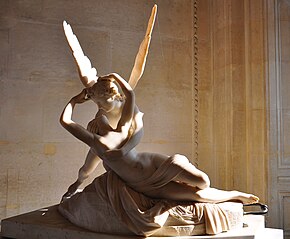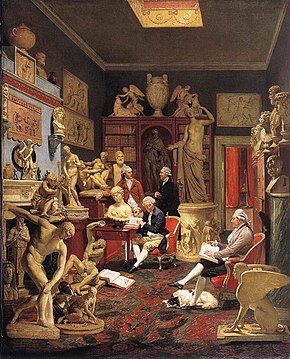
Back Neo-Klassisisme Afrikaans Klassizismus ALS الحركة الكلاسيكية الحديثة Arabic الكلاسيكيه المحدثه ARZ Neoclasicismu AST Neoklassisizm Azerbaijani Неакласіцызм Byelorussian Нэаклясыцызм BE-X-OLD Неокласицизъм Bulgarian Neoklasicizam BS


Neoclassicism, also spelled Neo-classicism, emerged as a Western cultural movement in the decorative and visual arts, literature, theatre, music, and architecture that drew inspiration from the art and culture of classical antiquity. Neoclassicism was born in Rome, largely due to the writings of Johann Joachim Winckelmann during the rediscovery of Pompeii and Herculaneum. Its popularity expanded throughout Europe as a generation of European art students finished their Grand Tour and returned from Italy to their home countries with newly rediscovered Greco-Roman ideals.[1][2][3][4] The main Neoclassical movement coincided with the 18th-century Age of Enlightenment, and continued into the early 19th century, eventually competing with Romanticism. In architecture, the style endured throughout the 19th, 20th, and into the 21st century.[5][6]
European Neoclassicism in the visual arts began c. 1760 in opposition to the then-dominant Rococo style. Rococo architecture emphasizes grace, ornamentation and asymmetry; Neoclassical architecture is based on the principles of simplicity and symmetry, which were seen as virtues of the arts of Ancient Rome and Ancient Greece, and drawn directly from 16th-century Renaissance Classicism. Each "neo"-classicism movement selects some models among the range of possible classics that are available to it, and ignores others. Between 1765 and 1830, Neoclassical proponents—writers, speakers, patrons, collectors, artists and sculptors—paid homage to an idea of the artistic generation associated with Phidias, but sculpture examples they actually embraced were more likely to be Roman copies of Hellenistic sculptures. They ignored both Archaic Greek art and the works of late antiquity. The discovery of ancient Palmyra's "Rococo" art through engravings in Robert Wood's The Ruins of Palmyra came as a revelation. With Greece largely unexplored and considered a dangerous territory of the Ottoman Empire, Neoclassicists' appreciation of Greek architecture was predominantly mediated through drawings and engravings which were subtly smoothed and regularized, "corrected" and "restored" monuments of Greece, not always consciously.
The Empire style, a second phase of Neoclassicism in architecture and the decorative arts, had its cultural centre in Paris in the Napoleonic era. Especially in architecture, but also in other fields, Neoclassicism remained a force long after the early 19th century, with periodic waves of revivalism into the 20th and even the 21st centuries, especially in the United States and Russia.[citation needed]
- ^ Stevenson, Angus (2010-08-19). Oxford Dictionary of English. ISBN 9780199571123.
- ^ Kohle, Hubertu. (August 7, 2006). "The road from Rome to Paris. The birth of a modern Neoclassicism". Jacques Louis David. New perspectives.
- ^ Baldick, Chris (2015). "Neoclassicism". The Oxford Dictionary of Literary Terms (Online Version) (4th ed.). Oxford University Press. ISBN 9780191783234.
- ^ Greene, Roland; et al., eds. (2012). "Neoclassical poetics". The Princeton Encyclopedia of Poetry and Poetics (4th rev. ed.). Princeton, NJ: Princeton University Press. ISBN 978-0-691-15491-6.
- ^ "Neoclassical architecture | Definition, Characteristics, Examples, & Facts | Britannica". www.britannica.com. 2023-06-01. Retrieved 2023-07-30.
- ^ "Classical / Classical Revival / Neo-Classical: an architectural style guide". www.architecture.com. Retrieved 2023-07-30.